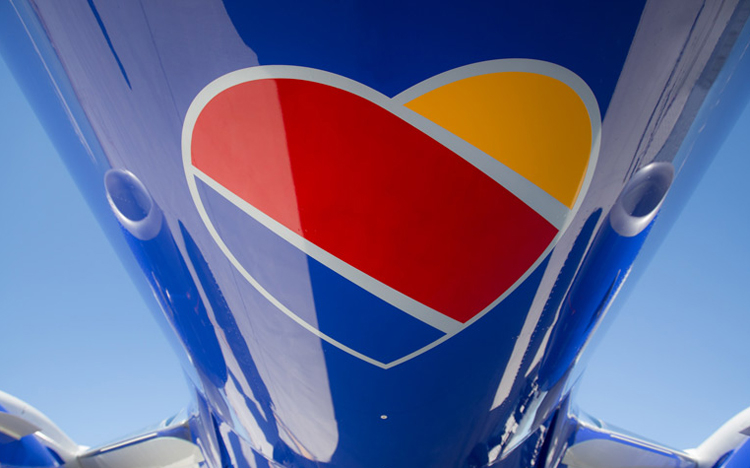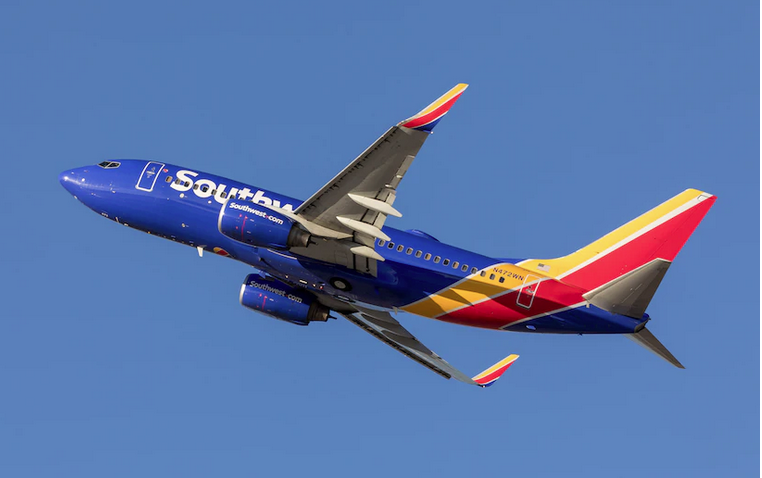Where’s the LUV?
IF YOU’RE GONNA ask me about the debacle at Southwest Airlines, there isn’t much I can tell you that you don’t already know. The normal media has covered the crisis ad nauseam, and has done a fairly good job of it.
In short, it began as an employee shortage during a storm in Denver. Hundreds of apron workers walked off the job after the airline reacted threateningly to a high number of sick calls. This gridlocked the operation in Denver, in turn cascading into a massive number of cancellations systemwide. An outdated IT infrastructure then handicapped attempts to get things restarted. Thousands of crewmmembaers needed to be re-routed, departures re-sequenced, and so on. Southwest’s logistics software couldn’t handle it.
And so on.
The “airline meltdown” has become a recurrent event — a revolving series of on-again off-again fiascos. Every few months, it seems, things at one of the big carriers go haywire for a few days. It happened to American, it happened to Sprit. In fact, isn’t the first time it happened to Southwest. In October of 2021 the airline canceled 2,000 flights over a four-day span after bad weather swept through Florida.

What happened over Christmas was the worst of the disruptions so far (the tab for Southwest is estimated at nearly a billion dollars), but it’s unlikely to be the last. The industry’s new normal, at least for now, is to operate right on the edge of crisis, with little margin for error. Flights are full and the skies are jam-packed with planes, while carriers — together with air traffic control, TSA, and pretty much every other moving part in the air travel machine — remain understaffed and inflexible, still playing post-pandemic catch-up.
Which brings us to something that’s been nagging me for quite some time:
Labor, or lack thereof, appears to be the biggest underlying culprit. People resigned or were let go en masse during the pandemic, and haven’t returned. And so the solution should be no more complicated than re-hiring enough workers to replace them. Indeed, companies are trying, only to be met with a lack of interest and position after position going unfilled. This is the case not only within the myriad businesses supporting air travel, but economy-wide, from convenience stores to restaurants to Uber drivers.
What nobody will explain is where all these workers disappeared to, and why they’re staying there. Are they sitting home playing video games and smoking weed? Did they find better jobs? Service workers and other comparatively unskilled employees have always been an integral part of the workforce, if not the very bedrock of it. Where has this sector been displaced to?
It’s possible I’m misreading things, and clearly this is a bigger and more complex situation than I’m equipped to explore on my own. If someone with expertise in the matter cares to explain, be my guest…

In the meantime, if you’ll permit me a diversion…
As Southwest takes a minute to catch its breath, it should consider a refresh of its ghastly paint job. I recommend something that doesn’t make every Southwest jet look like an amusement park ride.
The livery should better incorporate the carrier’s heart emblem. The heart, along with Southwest’s “LUV” stock ticker, harken to its origins at Love Field, in Dallas. It’s a fairly iconic logo, but one the airline inexplicably works to hide. It appears only as a small decal on the underside of the fuselage. This is a friendly and effective motif that absolutely belongs on the tail, in place of those awful red and yellow stripes.
Related Story:
AIR TRAVEL IS BROKEN. CAN IT BE FIXED?
737 Photo by Nick Morales/Unsplash




Leave a Comment
Maximum 1500 characters. Watch your spelling and grammar. Poorly written posts will be deleted!
25 Responses to “Where’s the LUV?”
You are viewing newest comments first. Click to reverse order
Lots of good explanations on here for the labor shortage. I’d also add that a number of people (often women) stepped back from the workforce during COVID to take care of their kids who were learning at home. Several of them didn’t return to the workplace after the pandemic.
Finally, the pandemic hastened the retirement of the very large baby boomer generation. With airlines offering early retirement packages, or furloughs, many of those workers did not return. This was true not just in airlines, but in many fields.
Shout-out to Greg: “Serious studies have found that the labor force shrank by about 500,000 workers who died because of Covid.”
Dead people can’t work! It seems people understand that low wages won’t cut it and better pay is mandatory. Yet we fail to understand that we lost so many lives in the last 3 years. Long Covid’s impacts remain to be fully understood, as it’s just coming into focus that there are folks who will be impacted long term, and unable to rejoin the workforce like before. Immigration policy over the last 10 years has also created a real gap in available workers. The world of work has changed significantly over the last 3 years and we are all trying to figure it out.
I think companies, air-carriers included- do not want to hire more staff. They want the most return with the least input as they want to recover quickly what they lost in Covid-times.That approach is not unexpected in business today. Winter weather problems have always been a problem in Denver and SLC too and I have 40 years experience there. They should have been more attentive to the history of dodgy airports.
Southwest have far too much paint on their planes.The extra weight would be the equivalent of 2 or 3 [maybe 4] additional passengers.They are throwing money away.
I think the problem in attracting workers is that companies are just not willing to pay a living wage. If they would pay a living wage, with decent health insurance, the worker shortage would disappear.
Airlines can’t continue to have the minimum possible staffing levels and then act surprised when something goes wrong.
I’ve worked ramp and gates for two airlines. Terrible jobs getting extremely low pay. Six months probation where if you are late for a total of two seconds you’re fired. Working mandatory overtime…all holidays. Sure, you get to fly standby for free…IF you can get on a flight and sleep in your rental car at your destination since you make 20k a year. Union fees, uniform fees etc…. Why would ANYONE do it? (Then again people work at airport fast food restaurants for even less pay, horrid commute and no flight benefits so….could be worse.)
As far as a new livery goes, I wouldn’t mind seeing something that better evokes a Southwest historical color scheme — russets, sunset colors, golden yellows, deep reds, sand, adobe buff, even desert pine green — I never think that the blue belongs in the current scheme. But I worry that any redesign will likely be worse than the current scheme, if history is any guide.
If only Southwest had pilot-less airplanes they wouldn’t have had to worry about crew swaps . . .
If SWA were to fold, does that mean Boeing will finally stop with the 737 and finally build the next-gen 757 or 767!
A man can dream… 🙂
I am laughing Patrick to the opportunity to take a whack at the livery. Definitely agree about the heart on the tail though.
It’s no mystery.
Serious studies have found that the labor force shrank by about 500,000 workers who died because of Covid. That’s collecting comments from Jerome Powell, Chair of the Fed. https://www.axios.com/2022/12/16/the-missing-workers-who-are-never-coming-back
That figure tracks with overall Covid deaths and labor participation rates. Per the same article, early retirements because of Covid cost another two million workers, and tightened immigration also had an effect. Long Covid probably hurts some, too.
https://www.businessinsider.com/covid-illness-made-labor-force-shrink-reason-for-labor-shortage-2022-9?op=1
Someone said “Low pay is better than no pay at all”- not necessarily! Yes, there are bills, but jobs can also mean added costs for things like childcare and commuting. It doesn’t make financial sense to accept a position that wouldn’t pay enough to cover the childcare you’d then need, for example.
A few weeks? (months?) ago I read on CBC News quotes from economists saying that the labour crunch is also being caused by the long-expected boomer retirement, and that the pandemic inspired many to retire a bit earlier than they might have otherwise. And so it’s somewhat easier for younger folks to move into better (and better-paying) jobs, leaving low-pay jobs even tougher to fill. The implication was that without a significant increase in the lowest wage tier, staffing shortages in such jobs have no hope of getting solved.
Eagerly waiting to hear your views on the “pissgate” that happened on Air India flight from New York to Mumbai….
Hello PS,
The reasons for labor shortages are multiple but you are rate that the “participation rate” is lower than pre-pandemic (https://www.bls.gov/charts/employment-situation/civilian-labor-force-participation-rate.htm). There has also been a change in attitude towards low-paying jobs, which represent a large portion of where the shortages are. One way to put it is that many people stopped accepting being paid so little.
A silver lining in all this is that it will hopefully lead to a rethink to easy airport security checks and more investments in technologies to “automate the passenger experience” (the constant document checks for international travel are an absurd frustration nowadays)
“A baby boom, James, takes far too long. We need immigrants.”
That comment was a slightly sarcastic comment, obviously it’d take 16-18 years before any baby conceived now could even start to enter the work force. But immigration to solve the labor gap may be harder than we think. The immigrants from overseas (Asia, Europe, Africa) aren’t going to come this far for unskilled jobs, they are only going to make the long trek here for skilled high-paying jobs (doctors, engineers, scientists, etc). Costs too much money to emigrate out overseas like that compared to lane crossings from the same contient. We’d be relying on land border immigrants and yes I know it seems like we’d have an un-ending supply coming from our southern border. But I don’t think it could fill the gap alone. I don’t know though.
I would claim there is no SHORTAGE of labor.
There IS a shortage of people who are willing to (or are forced to) work for sub-par wages.
If airlines cannot find enough ramp workers they need to raise salaries. They never have any problems raising their C-suite comp by several M$, so why should it be so hard to pay that ramp worker $17/hr instead of $15/hr?
Nobody cna tell me if you keep raising your salary you won’t eventually find hires. This is the very essence of free markets. Supply and demand. It’s just that country has not experienced that the employee side has had the upper hand in 5 decades. Well that time has now come and we obviously need to learn again how that works. Bottom line, if you’re hiring, you either raise your pay or you go without labor. Simple.
So how many of these service workers died during the pandemic.
How many were deported?
A baby boom, James, takes far too long. We need immigrants.
>>The industry’s new normal, at least for now, is to operate right on the edge of crisis, with little margin for error.<<
That's the heart of it. All the "fat" has been trimmed out of the airlines (and so many other businesses), and if even the tiniest thing goes wrong, there's no recourse. At the same time this is happening, executive compensation is the highest it's ever been. Companies are run like ATMs for the wealthy, not a wholistic business creating value for it's stockholders AND it's employees, vendors and customers.
I suspect cancelled flights and waiting on customer service for a whole afternoon isn't the worst of it, though. I worry the most about maintenance, especially on the heels of what seems to me to be and unusual number of planes forced to set down mid-flight because of various issues.
I doubt that Southwest will survive this. They’ll likely declare bankruptcy and be swallowed up by another airline, like Washington Mutual Bank in 2009.
This will be a shame, IMHO, because I prefer the way Southwest boards with no reserve seating. No other airline is will ever do this, so if we lose Southwest we’ve lost Southwest-style boarding forever.
Additionally, the fewer large airlines there are the more the remaining ones will behave like the phone company in 1975. They won’t care, because they won’t have to.
So I won’t be celebrating the impending demise of Southwest, although I’m sure their competition will be.
Matt above gets to the heart of the matter. We are living through a plague. Plagues remove large numbers of people from the labor force. This creates a demand crunch, as there are simply not enough workers left to staff all businesses at pre-plague levels. It takes a long time for demographics to recover.
Beyond excess mortality, there are other ways a plague can remove people from the workforce. Maybe they lived, but were saddled with ongoing health problems that forced them to curtail their participation in the workforce. Maybe they are fine, but have had to pull back from wage labor in order to care for a loved one who isn’t, or to spend more time caring for children, because there aren’t as many workers in the care sector as there used to be either. Maybe they were nearing retirement age, and chose to retire early rather than deal with a job that required them to routinely expose themselves to possible infection.
The industries that suffer most in this situation tend to be those that rely on unskilled labor. The plague opens up a bunch of jobs that come with higher pay, and makes the employers who offer those jobs happy to accept workers for them that they would not have accepted pre-plague, since the alternative is competing harder for the remaining skilled workers by raising wages. Unskilled workers who can grab one of those opportunities do so. This pools the biggest labor shortages at the bottom of the economic ladder.
I’ve thought about the understaffing issue quite a bit over the past few years, and I, too, have struggled to understand *why* there seem to be staffing shortages everywhere. The quick answer is that employers just aren’t offering to pay enough, but I find that unsatisfying in a country where over half the population would be unable to handle a surprise bill of just a few hundred dollars. Low pay is better than no pay at all, and I don’t expect many to be able to hold out for some mythical high-paying low-requirements job before bills start coming due.
As with everything, I suspect that the answer is complicated and involves many factors.
Ever since I first hired on with my current employer over 15 years ago, there has been considerable hand-wringing about the age of the workforce. A distressingly high percentage of workers were at or nearing retirement age. I don’t know what the demographics are like today, but over the past 3 years, I watched many of my more experienced colleagues take that plunge into retirement. I suspect that many others across multiple industries have done the same, leading to many open positions.
On a somewhat morbid note, Excess mortality (the difference between the number of people statistically expected to die from all causes in a given year compared to those who actually died) has been historically high throughout 2020, 2021, and the first quarter of 2022. A LOT of people sadly lost their lives over the past few years, and that may factor in.
Patrick is absolutely correct about the causes of the SWA debacle: lack of both sufficient labor and up-to-date technology. But what were the causes behind the causes? Answer: the prioritizing of shareholder profit (especially for the company’s executives), spurred primarily by massive stock buybacks. Here are three article to get you started:
https://accountable.us/watchdog-southwest-cancellation-crisis-follows-execs-choice-to-reward-5-6b-to-shareholders-instead-of-investing-in-infrastructure/
https://www.nytimes.com/2022/12/31/opinion/southwest-airlines-computers.html
https://www.dailykos.com/stories/2022/12/30/2144500/-Was-the-Southwest-Airlines-Meltdown-Caused-By-the-Great-Share-Buyback-Scam
Also, completely agree on Southwest’s livery. It could be one of the coolest ones out there with the heart on the tail and appropriate cheat lines. But you know, if they update it, we’ll end up with your favorite, a good old swooshy curvy messy set of lines and letters.
You hit the nail on the head. Everywhere I go…hotels, retail, restaurants, rental car counters, etc. The service is slow and the disclaimer frequently is “we are short-staffed”. In order to attract more labor, a business would have to raise pay rates. Which raises the costs of goods and services, which is why we are in an inflationary situation. Then it circles back where with rising prices who wants to work for minimal wages? The only way out may a recession, where people become desperate to work anywhere.
But where are the workers now? My guess is a combination of people not in the labor market anymore (whether they are “sitting home playing video games and smoking weed”, hiking, living with mom and dad, going back to school for a degree or a masters all of the above) and also, fewer service workers overall as our population is aging. I feel like services workers trend to the younger end, especially retail, restaurants, etc. As our country’s average age is increasing, we have more older folks looking for service, either leisure or out of necessity for health, and less younger people to provide it.
So I guess we need a recession and a baby boom.